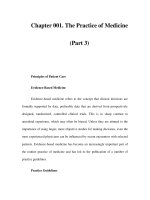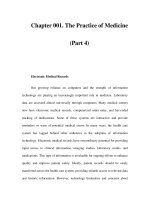Chapter 001. The Practice of Medicine (Part 1) ppt
Bạn đang xem bản rút gọn của tài liệu. Xem và tải ngay bản đầy đủ của tài liệu tại đây (18.01 KB, 5 trang )
Chapter 001. The Practice of Medicine
(Part 1)
The Modern-Day Physician
No greater opportunity, responsibility, or obligation can fall to the lot of a
human being than to become a physician. In the care of the suffering, [the
physician] needs technical sk
ill, scientific knowledge, and human understanding. .
. . Tact, sympathy, and understanding are expected of the physician, for the patient
is no mere collection of symptoms, signs, disordered functions, damaged organs,
and disturbed emotions. [The patient]
is human, fearful, and hopeful, seeking
relief, help, and reassurance.
–Harrison's Principles of Internal Medicine, 1950
The practice of medicine has changed in significant ways since the first
edition of this book appeared in 1950. The advent of molecula
r biology with its
enormous implications for the biological sciences (the sequencing of the human
genome), sophisticated new imaging techniques, and advances in bioinformatics
and information technology have contributed to an explosion of scientific
inform
ation that has fundamentally changed the way we define, diagnose, treat,
and prevent disease. This explosion of scientific knowledge is not at all static as it
continues to intensify with time.
The widespread use of electronic medical records and the Inte
rnet have
altered the way we practice medicine and exchange information. As today's
physician struggles to integrate the copious amounts of scientific knowledge into
everyday practice, it is important to remember that the ultimate goal of medicine is
to tr
eat the patient. Despite more than 50 years of scientific advances since the
first edition of this text, it is critical to underscore that cultivating the intimate
relationship that exists between physician and patient still lies at the heart of
successful patient care.
The Science and ART of Medicine
Science-
based technology and deductive reasoning form the foundation for
the solution to many clinical problems. Spectacular advances in biochemistry, cell
biology, and genomics, coupled with newly developed i
maging techniques, allow
access to the innermost parts of the cell and provide a window to the most remote
recesses of the body. Revelations about the nature of genes and single cells have
opened the portal for formulating a new molecular basis for the phy
siology of
systems. Increasingly, we are understanding how subtle changes in many different
genes can affect the function of cells and organisms. We are beginning to decipher
the complex mechanisms by which genes are regulated. We have developed a new
appr
eciation of the role of stem cells in normal tissue function and in the
development of cancer, degenerative disease, and other disorders. The knowledge
gleaned from the science of medicine has already improved and undoubtedly will
further improve our under
standing of complex disease processes and provide new
approaches to disease treatment and prevention. Yet skill in the most sophisticated
application of laboratory technology and in the use of the latest therapeutic
modality alone does not make a good physician.
When a patient poses challenging clinical problems, an effective physician
must be able to identify the crucial elements in a complex history and physical
examination, to order the appropriate laboratory tests, and to extract the key results
from th
e crowded computer printouts of data to determine whether to "treat" or to
"watch." Deciding whether a clinical clue is worth pursuing or should be
dismissed as a "red herring" and weighing whether a proposed treatment entails a
greater risk than the disea
se itself are essential judgments that the skilled clinician
must make many times each day. This combination of medical knowledge,
intuition, experience, and judgment defines the art of medicine
, which is as
necessary to the practice of medicine as is a sound scientific base.
Clinical Skills
History-Taking
The written history of an illness should include all the facts of medical
significance in the life of the patient. Recent events should be given the most
attention. The patient should, at some early poi
nt, have the opportunity to tell his
or her own story of the illness without frequent interruption and, when appropriate,
receive expressions of interest, encouragement, and empathy from the physician.
Any event related by the patient, however trivial or s
eemingly irrelevant, may
provide the key to solving the medical problem. In general, only patients who feel
comfortable will offer complete information, and thus putting the patient at ease to
the greatest extent possible contributes substantially to obtai
ning an adequate
history.
An informative history is more than an orderly listing of symptoms; by
listening to patients and noting the way in which they describe their symptoms,
physicians can gain valuable insight into the problem. Inflections of voice, fa
cial
expression, gestures, and attitude, i.e., "body language," may reveal important
clues to the meaning of the symptoms to the patient. Because patients vary in their
medical sophistication and ability to recall facts, the reported medical history
should
be corroborated whenever possible. The social history can also provide
important insights into the types of diseases that should be considered. The family
history not only identifies rare Mendelian disorders within a family but often
reveals risk factors
for common disorders such as coronary heart disease,
hypertension, or asthma. A thorough family history may require input from
multiple relatives to ensure completeness and accuracy. However, once recorded,
it can be readily updated. The process of history-
taking provides an opportunity to
observe the patient's behavior and to watch for features to be pursued more
thoroughly during the physical examination.
The very act of eliciting the history provides the physician with the
opportunity to establish or enh
ance the unique bond that forms the basis for the
ideal patient-
physician relationship. This process helps the physician develop an
appreciation of the patient's perception of the illness, the patient's expectations of
the physician and the health care sys
tem, and the financial and social implications
of the illness to the patient. Although current health care settings may impose time
constraints on patient visits, it is important not to rush the history-
taking since the
patient may get the impression that
what he or she is relating is not of importance
to the physician and therefore may hold back relevant information. The
confidentiality of the patient-physician relationship cannot be overemphasized.









